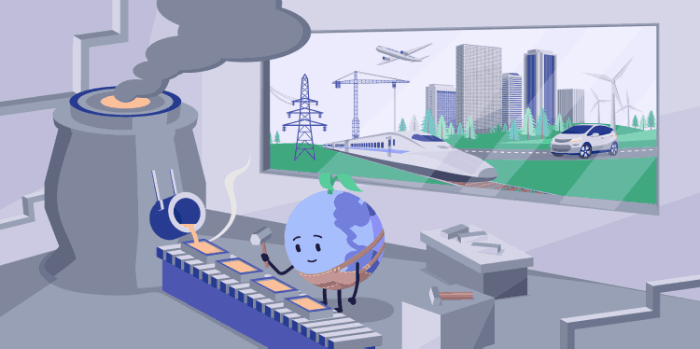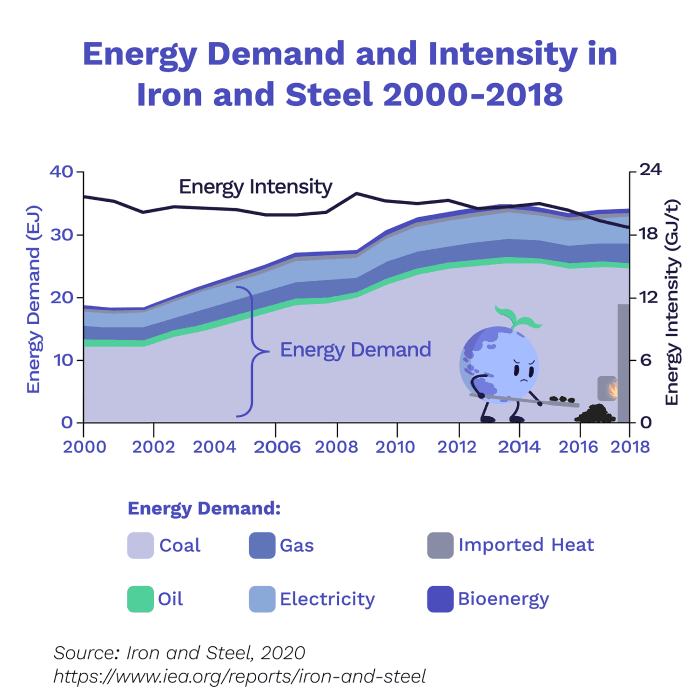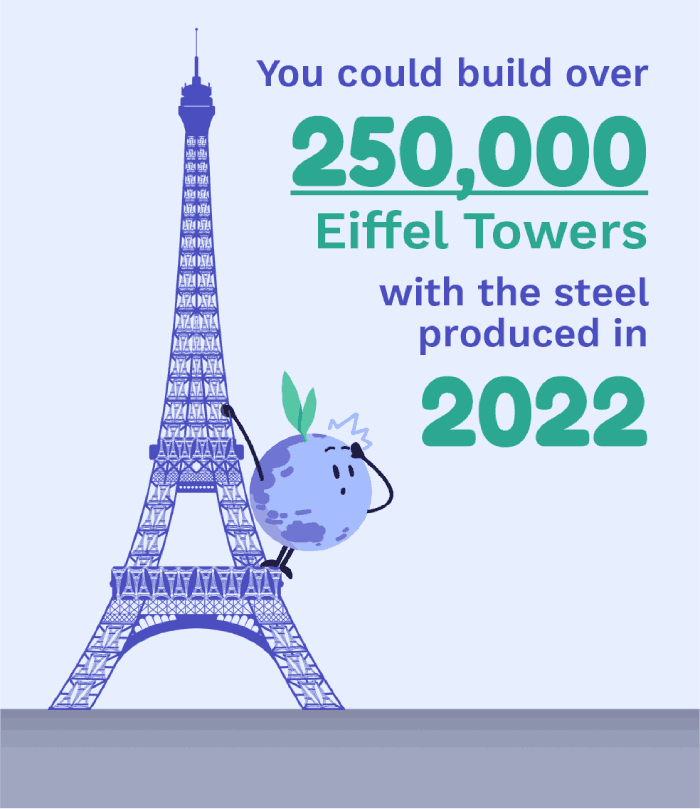Sustainable Steel: What’s Climate Change Got to Do with Steel?
11 minute read
Updated on: 29 Apr 2021

The industrial revolution hugely changed the way in which we produce consumer goods. By taking advantage of newly-discovered electricity and economies of scale we have been able to build the giant industrial sector we know today. However, while this has enabled great strides in human development, industry as a whole was responsible for 29.4% of all greenhouse gases emitted in 2016 .
Most of those emissions come from burning fossil fuels to power the machines and factories used to make everything from cars to matches . The remaining emissions come as by-products from chemical processes, such as making cement and agricultural fertilisers
.
This course will take you through many of the new and imaginative ways in which we are trying to make industry less polluting and more sustainable. Let’s start with steel!
In 2019, 240kg of steel were produced for every person on Earth ! Indeed, global demand for steel is so high that the iron and steel industry alone contributes approximately 6.7% of global CO₂ emissions
!
What is steel?
Steel is an alloy. This means it’s a combination of metals, specifically iron with some carbon added for strength. Mixing this with certain other elements can create many different types of steel .
Below we can see an example of the composition of a specific kind of steel:
How much does this industry contribute to climate change?
Steel has the potential to be a very sustainable material because it lasts a long time, is very strong, and is easy to recycle .
However, because of the dependency on coke (made by heating coal to high temperatures) as a key raw material and fossil fuels for operations, steel production is quite an energy intensive process.
For every tonne of steel produced, around 1.7 to 1.9 tonnes of CO₂ are emitted . This is a big problem for climate change when you consider the size of the steel industry; to give you an idea, in 2019 about 1868.8 million tonnes of steel were produced
!
Unfortunately, the story doesn’t end at CO₂ emissions. Steel production also produces harmful and polluting compounds such as carbon monoxide (CO), nitrous oxide (N₂O) and sulfur dioxide (SO₂) which contribute to acid rain, affecting soil and vegetation . Also, the heating of coke in the blast furnace emits a substance called naphthalene
, which is thought to cause cancer
.
How is steel made?
Steel production involves three main stages :
- Preparing raw materials (coking)
- Ironmaking
- Steelmaking
Preparing raw materials - Coal is heated in an oxygen-free environment to create coke, a carbon-rich fuel which is responsible for a large portion of emissions from steel production .
Ironmaking - Coke is heated in a blast furnace along with limestone and iron ore. The limestone removes impurities and is turned to ‘slag’ while the iron ore is reduced into molten iron . Reduction in this case involves removing oxygen and adding hydrogen to the ore.
Steelmaking - Finally, impurities are removed from the molten iron to create steel .
Newer methods are more efficient but still based on those same three stages . Using these stages there are two main ways to produce steel:
- Blast Furnace - 70% of all steel is produced this way
. It uses molten iron ore as the starting material and coke as the reducing agent
.
- Electric Arc Furnaces (EAF’s) - these produce 25% of all steel. Here, recycled steel is used as the starting material
. Compared to blast furnaces, these furnaces are smaller and don’t need coke as a reducing agent (as they use electricity to melt the iron ore), so they produce much less CO₂
. They’re also cheaper to run than blast furnaces
!
Which countries have the biggest share in the steel industry?
The steel production market is dominated by China, followed by India and Japan . Developing countries are far more likely to dominate future increases in consumption due to expected economic growth. India is predicted to have the highest growth of 400% from 2015 to 2050, followed by African and Middle Eastern countries
.
What can be done to reduce emissions?
To keep global warming below 1.8°C, CO₂ intensity of steel would need to fall an average of 2.5% annually from now on until 2030 . The current trend does not follow this reduction path. Therefore, it is essential that we make the changes necessary to decarbonise the industry.
Remember, emissions in steel production are an effect of using coke as a reducing agent and from different operations within the production chain. So how do we reduce these emissions?
By either dealing with the material that produces emissions (i.e. coke) or dealing with the emissions themselves. How?
Recycling
Steel is 100% recyclable, hence using steel scrap is one way companies are trying to reduce emissions. This process uses 56% less energy than producing new steel . In 2018, scrap-based production accounted for ~20% of the total production in Electric Arc Furnaces, but in order to keep in line with the Paris Agreement scrap needs to be used in 40% of all crude steel production by 2030, not just EAF’s
.
Direct Reduced Iron
Instead of using coke to reduce the iron we can use hydrogen as an alternative reducing agent. Using hydrogen in this way could eliminate CO₂ from the steel making process as it only generates water vapour (unlike coke) ! Although not yet commercialized, many companies have found this technology to be viable.
Three Swedish companies created an initiative called Hydrogen Breakthrough Ironmaking Technology. It aims to significantly increase energy productivity and reduce CO₂ emissions using hydrogen, produced by electrolysis, as a reducing agent !
Another team in Sweden is working on the world’s first industrial scale fossil-free steel production plant. The plant aims to use biomass (residue from forestry) as fuel instead of the conventional fossil fuels and aims to reduce CO₂ emissions by 10,000 tonnes annually.
Electrolysis
This method basically uses electricity instead of heat to reduce iron ore. The ore is dissolved in a molten solution and current is passed through it . This method, however, still has some technical issues, such as high costs and high energy uses, but many are working to solve these issues
.
What’s stopping us?
When considering alternatives, it is vital to assess their feasibility. For the steel industry, it is very difficult to follow a decarbonisation path without raising costs significantly.
This is partly because a lot of the suggested decarbonizing methods involve new technologies. For example, because it is in an early stage of development, accessing the hydrogen used in the direct reduced iron (DRI) from clean energy sources could increase the cost by 20% !
Using carbon capture technologies (which are still in pilot stage) throughout the steel manufacturing process could increase the cost by 100% for every tonne produced .
Even when it faces many financial challenges and implementation barriers, there is a lot of research and development going on around the world and a lot of opportunities for decarbonizing the industry so watch this space! Steel is often combined with concrete in construction so we will look at concrete next!
Next Chapter








